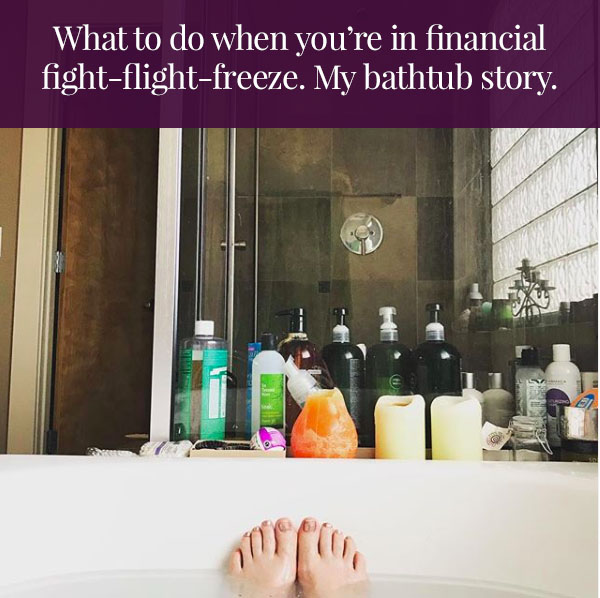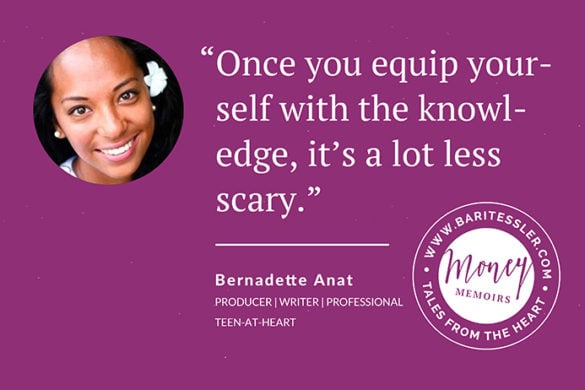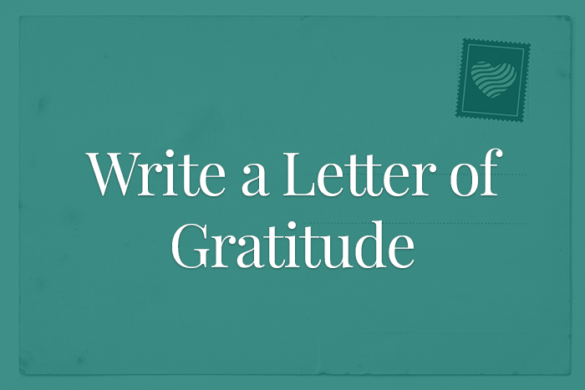What do you do when life throws you a major money curveball?
What do you actually do? How can you sort through all of your emotions, fear, and shock, so you can see clearly? How do you soothe your body and heart when they’re in money panic mode? What do you actually do, in the middle of any given Tuesday afternoon?
Today, I’d like to tell you the real, from-the-trenches story of a big financial trauma I faced — and exactly how I worked through it, in the middle of the afternoon … in my bathtub.
Put your feet up (or head out for a stroll) and listen to an audio version of this article here.
I hadn’t slept through the night for 2 weeks. And I’m a professional sleeper.
I kept waking up at 3AM, my mind and heart racing with money anxiety. And during the day, I just felt “off” and disconnected from myself.
See, two weeks prior, a letter arrived from the IRS. When I saw what it said, I ran into the kitchen in a panic to tell my husband Forest.
“Honey, we’re being audited!”
I don’t think that’s fun news for anybody — but it’s a particularly complex, scary scenario for a dual-entrepreneur household like ours. And no matter how much Forest told me everything would be OK (after all, we keep impeccable records and are very honest about deductions), I was still worried.
For the next two weeks, I was disconnected from myself. Distracted. Worried and stressed.
You see, it doesn’t matter how long we do our “money work,” life can still throw us big curveballs (and will!). I’ve been doing deep, emotional, and practical money work for decades, now — but life still throws me surprises like this. I still have emotional reactions to sort through and new practical solutions to learn.
The point of money work isn’t to avoid every financial stress and situation in life. That’s impossible. The point is to give ourselves the tools and resources to deal more consciously and compassionately with money situations when they inevitably arise.
And as the rest of this story illustrates, the best tools and resources to begin with aren’t always outside of ourselves — spreadsheets and accountants are important, but we often need to give our emotions and bodies some loving attention, first.
After two weeks of audit anxiety, one afternoon I knew what to do.
It was the middle of the afternoon, and I was working in my home office. An idea popped into my head: I needed a long, hot bath.
Now, I love a good bath, and it’s long been one of my favorite self-care practices. But I’ve also turned to baths over my life to do deep, emotional work. There’s something about being held in that warm water that helps me feel connected to something greater, so I can reflect, feel my feelings, and start to move things through. I had a feeling this was going to be one of those baths.
After a few minutes of soaking in that hot, hot bath, I realized what was going on — what had been happening, for the past two weeks.
I was in a full-blown fight-flight-freeze fear response!
Fight, flight, and freeze are three ways our bodies express and experience fear. They’re primal responses, survival strategies. But they can also wreak havoc in us when we don’t let them move through us completely — even creating trauma. As one of our Art of Money TA’s, somatic psychotherapist Sonya Brewer explains,
“We come equipped with all sorts of resources that are built into our bodies to help us respond to threats without us having to think about it. It’s kind of amazing: your body knows to run if it senses a predator is lurking, to freeze if no escape is possible, to fight when backed into a corner, to submit or appease when ‘showing one’s belly’ is likely to buy you some time, or to cry out in such a way that other humans feel compelled to respond, even in the face of danger.
These responses: flight, fight, freeze, submit, and ‘attached cry for help’ are animal defenses that are hardwired into our bodies. The body acts, within milliseconds. We’re supposed to be able to protect ourselves in these ways.
Trauma symptoms emerge not because we are broken but because our bodies’ natural responses get overwhelmed beyond our ability to respond to what is happening: these very intelligent responses get interrupted. This interruption can show up like a traumatic response, as the body continually loops through the interrupted impulses, seeking a route towards completion. So trauma resolution is about supporting the body to do what it is wired to do.
We have built-in mechanisms for resolving overwhelming experiences, and somatic trauma work is about helping us access those inner resources. It is through accessing the wisdom of our bodies that we learn to heal.”
Thanks to my somatic psychology training, I’m deeply familiar with these ideas around trauma and fight-flight-freeze and how this all happens in the body … yet it wasn’t until I was there, soaking in that warm water, that I realized that I was in the middle of a fear response!
That’s actually a symptom of a fear response, by the way: our higher reasoning gets a little hijacked, since our body is prioritizing survival, not creative problem solving. Have you ever been upset/scared/overwhelmed … and only once you calmed down could you see a solution? Yep. That.
Over the next half hour or so in the tub, I guided myself through a simple process to unwind my fear response … and see my next money steps more clearly. Please feel free to borrow and modify this the next time you’re overwhelmed with emotions, stuck in a money riddle (or “koan”), or just need a fresh perspective.
Bari’s Bathtub Process: How to get out of fight-flight-freeze and move forward.
- Give your body some soothing support. When we’re financially or emotionally stressed, our bodies are stressed, too. So give your body some love! The warm bath water works wonders for me, but maybe you’d prefer a cozy blanket and incense, a massage, or getting some sun at the park. Listen to what your body would find comforting and try not to rush: our bodies move at a slower pace than our quick thoughts!
- Name what’s happening. There’s something magical and healing about putting words to a situation — even when we don’t change it. When I said to myself, “I’m in fight-flight-freeze,” it was a huge relief. I knew where I was. The simple act of naming what’s happening allows us to put it to the side and start being less overwhelmed by it. You might notice a fear response — or you might simply say to yourself, “I’m in a big money conundrum right now,” or, “I’m in a cashflow dip,” or “I’m in a life transition, and it’s impacting my money relationship.”
- Notice your emotions. Next, I checked in with my bodily sensations and emotions. “What feelings am I experiencing right now?” Again, I simply named them — without judgment or trying to change anything, just simply noticing and naming. I scanned my body and noticed: I was feeling a lot of fear, a lot of “freeze” response. I also felt invaded and angry.
- Name your thoughts. Next, I asked myself: “what does this remind me of?” I realized I was remembering an audit my parents had when I was younger, and how challenging that was. We all have our unique Money Stories: the whole constellation of our personal histories and associations, patterns and lineages around money. So when something big happens in our money lives, it can be helpful to just check in with the past and name what this is reminding us of. (Hint: this helps bring us more into the present!)
- Ask at least one new question. When we ask new questions — instead of swirling in the same old, unhelpful ones like “why did this happen?” — new ideas can arise! I asked myself some more supportive questions in the bathtub, like: “Do I have really good support?” Yes, I had a great accountant. New questions can lead to new insights — and before you know it, things can feel a little more hopeful and manageable.
By the time my bath was over, things looked a bit brighter.
My big money curveball wasn’t over, by any means. The audit would take many months and a lot of work to resolve. But in just a half hour, that bath — and the simple process I guided myself through — had me feeling completely different. I wasn’t sure how things would resolve, but I knew they would. And sometimes, a little hope, grounding, and comfort is all we need to keep going and take our next helpful steps.
This is why body-based and emotional practices are SO fundamental in money work.
Listen. Money pulls on deep, primal threads. Money is never just about the money.
Dealing with “money stuff” can be overwhelming and send us straight into survival mode, fear, or other strong, body-based feelings and emotions. In fact, all of the same emotions that come up around every other area of life come up around money!

This surprised me when I first began my emotional and psychological money work. Like many people, I had assumed “working on money stuff” just meant attending to the practical aspects — and if I couldn’t “just do it” or didn’t know how, something was wrong with me.
Luckily, my training as a somatic therapist nudged me to realize pretty quickly that the only way I could have a relationship with money was by bringing all of my somatic tools and practices along. I couldn’t have deep meaning and personal growth and authentic movement in one room of my life and money in a separate room. I needed to bridge these worlds. So I began exploring the emotional side of money.
Emotions occur on a wide spectrum: from shame, anger, anxiety, grief, and guilt — to joy, excitement, and hope … and everywhere in between. There are also more extreme, body-based reactions like fight, flight, and freeze.
Emotions come up, around money. We’re human, folks! Emotions come up in every area of our lives. And when they’re big, powerful emotions and we don’t know how to work with them, they can derail us from moving forward with clarity.
That’s why working on “money stuff” must start with learning to navigate your emotions. Or, as I recently put it at the Women in the World Summit, “Financial literacy and emotional literacy go hand-in-hand.”

Remember: we can’t think our way out of feelings! The best we can do is say hello to them, calm ourselves down a bit, and stay gentle with ourselves as we allow our feelings to move through. But there are tools to help you sit with, understand, and work through your emotions better. You can take a bath, move through the process I outlined above — or you can start with the simplest practice I teach: The Body Check-In.
The Body Check-In is the foundation of my entire money healing approach with good reason. This ultra-simple, simply life-changing practice will help bring you into your body, into your emotions, and into the present moment. {Learn how to do it here.}
Like meditation, exercise, or gardening, the Body Check-In is a practice. It’s not something to do just once in a blue moon (or when you’re particularly overwhelmed). Practice it on good days and bad, tough days and triumphant ones, so you build your capacity to stay present, no matter what.
Some of my community members put Post-It notes on their computer screens, on their debit cards, or on the dashboards of their car to remind them to “CHECK IN.”
Get more support if you need it.
Some of us will need a little extra support here, especially if we uncover deep trauma. You may want to work with a somatic therapist or some other kind of healer or guide. Remember: asking for help is sometimes the wisest, strongest thing you can do!
If you find yourself stuck in your money world — unsure what practical step to take next or are having a challenging money conversation, for example — it might be time to set aside the spreadsheets for a moment … and look at your emotions.
Patience and practice and presence and compassion, my friend.
Remember: these tools are here to support you, to nourish you, to guide you into more clarity and well-being.
Do not turn them into more To Do items to shame yourself over if you forget. Do them when you can. And do not criticize yourself for doing them “wrong” or not being “good enough” at them. Like anything, these practices take time to learn. Get the support you need, and go at your own pace.
With a little persistence and patience, these tools can bring you into a more gentle, loving relationship with yourself — and your money.
Practice them often. Even when things are going well! That way, the next time life throws you a financial curveball … whether it’s an audit or an unexpected raise or simply a rush of adrenaline — you’ll be able to name your feelings, stay in your body, ask good questions, and move forward.
Here’s to body wisdom, afternoon baths, and facing money challenges with presence and compassion.
With my dearest wishes,






